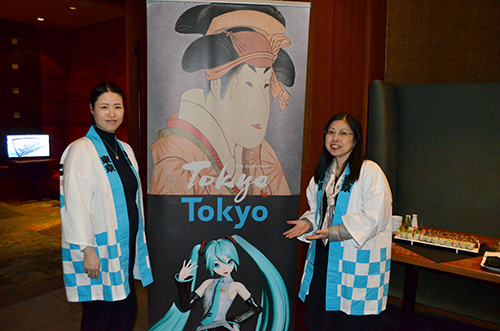It's a big year for Tokyo. Japan's capital city is gearing up to host the Summer Olympic and Paralympic Games in JUL, AUG and SEP 2020, and a number of shiny new sports venues stand ready to impress the millions of visitors who will flood Tokyo to cheer on their favourite athletes.

Shin Kawai, Director, Tokyo Convention & Visitors Bureau.
But Tokyo -- with its balance between tradition and modernity, pockets of serenity and thrilling cacophony -- was a bucket list destination for many before Tokyo was selected as Olympic host. And it still has a lot more than sports to offer visitors, Shin Kawai, Director of the Tokyo Convention & Visitors Bureau, told Open Jaw at a media event hosted in partnership with the Travel Media Association of Canada at Ki Modern Japanese + Bar.
Like food.
Cuisine "opens a window into Japanese culture," says Kawai. Media attending the event got to peer through the glass as they were treated to a selection of delectably vibrant sushi and a sampling of sake (Japan's traditional fermented rice drink) at Ki.

Kaori Kubo (left) and Sumi Sato with Japan Communications Inc.
When conjuring images of Tokyo, mammoth skyscrapers and state-of-the-art gadgets may come to mind. These elements are appealing in their own right, but Kawai says there's also a strong natural element to the destination.
Okutama, for example, a town located in the western part of Tokyo, is known as a hidden oasis. Just a short train ride away, travellers can find serene lakes and picturesque mountains, all without ever leaving Tokyo. The Tokyo prefecture even includes a large number of small islands, some over 1,000 km from the mainland.
"Tokyo is a juxtaposition of old traditions and the latest innovations and technology, but it's all related and rooted in the same thing," says Kawai. "Tokyo is very diverse. It's a cluster of small villages, each with its own character and lifestyle, local food and history. That's why visitors can come back many times and still find many new things to see and do."

This is how we roll at a Tokyo tourism event.
When planning an itinerary, Kawai suggests travel advisors determine their clients' interests – whether it's food, anime and manga, history, outdoor adventure, sacred places, movie filming locations or the other myriad of experiences that Tokyo has on offer – and build an itinerary around that.
But at the root, he says there needs to be a cultural element.
"When people from Canada travel to Europe, it's a different country but it still has many similarities to their life back home," he says. "Tokyo has a completely different culture, and that is a fascination for many tourists."

Michael Tremblay served guests a flight of different sakes (traditional fermented
rice drink in Japan). He is one of 70 “sake samurais” in the world.
That cultural element can be found in immersive experiences that combine both old and new. Travellers can participate in a sushi-making experience, or a ninja workshop using VR. They can learn to cook soba noodles, try traditional wrestling, master flower arranging, take a taiko drumming lesson… The list really does go on.
As far as Tokyo's appeal to Canadian travellers, Kawai says the Canadian market performed "very well" in 2019, with more than 300,000 visitors arriving in Japan. And with direct flight service available from YUL, YYZ and YVR, Kawai says he expects the interest to continue growing.

Anna Kroupina Journalist
Anna is OJ's newest member and she joins the team as a writer/reporter. She co-writes the daily news and covers events. Although she's new to the industry, pursuing a career path in travel/tourism has been a goal since her first family road trip to the Florida Keys sparked a desire to discover the world and this exhilarating, fast-paced industry





